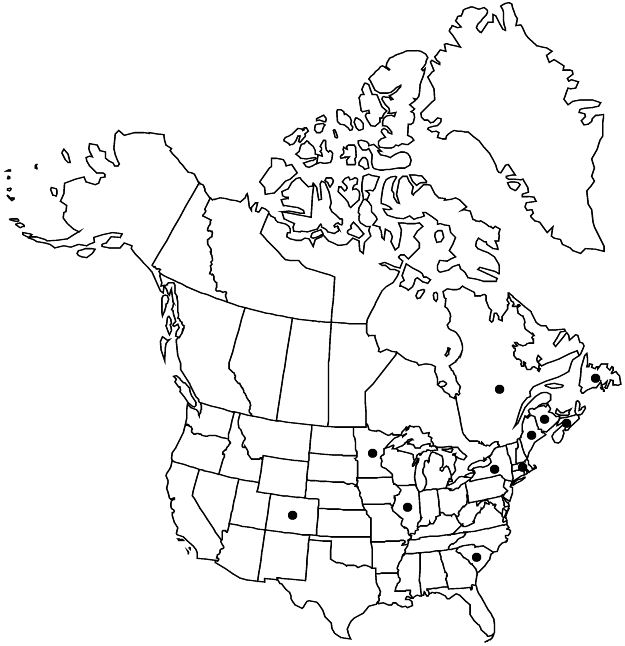Rosa glauca
Hist. & Mém. Acad. Roy. Sci. Toulouse 3: 326. 1788.
Shrubs, erect and tall. Stems ± flexuous, erect, to 20 dm, sparsely branched, distal branches and leaves glaucous, with purplish bloom; bark becoming red-brown, glabrous; infrastipular prickles absent, internodal prickles sparse or absent, aciculi absent or erect, curved, or declined, subulate, 2–5 × 1.5–4.5 mm, base mostly broad, eglandular. Leaves 6–10.5 cm; stipules 13–16 × 1.5–2 mm, auricles flared, 2.5–5 mm, margins entire, eglandular or sparsely gland-fringed, surfaces glabrous, eglandular; petiole and rachis usually with pricklets, glabrous, eglandular; leaflets 5–7(–9), terminal: petiolule 10–20 mm, blade narrowly elliptic to ovate, 20–45 × 15–25 mm, leathery, base cuneate, sometimes rounded, margins 1-serrate, eglandular or few gland-tipped, teeth 12–18 per side, eglandular, apex acute, abaxial surfaces pale green, sometimes dull red, glaucous, glabrous, eglandular, adaxial green-red or purplish, glaucous, dull, glabrous. Inflorescences corymbs, rarely panicles, 1–5-flowered. Pedicels erect, slender, (10–)15–25 mm, glabrous, stipitate-glandular; bracts 1 or 2, narrowly ovate-lanceolate, 8–23 × 3–6 mm, margins entire, eglandular, surfaces glabrous, eglandular. Flowers 2–3 cm diam.; hypanthium narrowly ovoid, 5.5–7 × 3.5–5.5 mm, glabrous, eglandular, neck purplish, absent or 1 × 2 mm; sepals spreading, lanceolate, 15–25 × 1.5–2 mm, tip 10–15 × 1 mm, margins entire, sometimes pinnatifid, abaxial surfaces glabrous, mostly stipitate-glandular; petals single, deep pink to crimson-red, sometimes white basally, 8–14 × 5–6 mm; carpels 30–32, styles exsert 1–2 mm beyond stylar orifice (1.5–2 mm diam.) of hypanthial disc (3 mm diam.). Hips dark brownish red to crimson red, globose, ovoid, or obovoid, 10–13 × 9–11 mm, fleshy, glabrous, eglandular, neck absent; sepals deciduous as hips mature, erect to spreading. Achenes basiparietal, 15–23, light tan to tan, 4–4.5 × 2.5–3 mm. 2n = 28.
Phenology: Flowering May–Jul.
Habitat: Roadsides, wastelands, neglected areas
Elevation: 0–2000 m
Distribution

Introduced; N.B., Nfld. and Labr. (Nfld.), N.S., Que., Colo., Ill., Maine, Mass., Minn., N.Y., S.C., c, s Europe, introduced also in n Europe.
Discussion
Rosa glauca, included by A. Rehder (1940) in sect. Caninae, belongs in sect. Rosa (I. Klášterský 1968).
Rosa glauca is an infrequent introduction to the flora area from the mountains of Europe. As its garden cultivation increases, the species will continue to spread and become naturalized. The following collection label is a perfect illustration: W. A. Weber 15003 (COLO, NY), 19 June 1973, at Boulder, Colorado, found at the bottom of Gregory Gulch at West end of Baseline Rd., north slopes at base of talus slides, 2000 m, thoroughly naturalized cultivar, probably spread by jays from adjacent city. The shrubs usually produce abundant hips and achenes as well as rhizomatous shoots; once established the plants reproduce vegetatively and sexually.
Rosa glauca consists of erect shrubs reaching 20 dm; more or less flexuous stems and glaucous distal branches have a purplish bloom with sparse or no broad-based internodal prickles. Leaflet blades are glaucous abaxially and often crimson-red; adaxially, blades are purplish-glaucous.
The taxonomic affiliation of the name Rosa ferruginea Villars is uncertain.
Selected References
None.